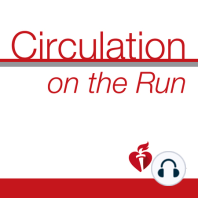17 min listen
Circulation January 17, 2017 Issue
ratings:
Length:
26 minutes
Released:
Jan 16, 2017
Format:
Podcast episode
Description
Dr. Carolyn Lam: Welcome to Circulation on the Run, your weekly podcast summary and backstage pass to the journal and its editors. I'm Dr. Dr. Carolyn Lam, associate editor from the National Heart Center and Duke National University of Singapore. In today's episode, we are discussing very important new data regarding stroke risk stratification in patients with atrial fibrillation. First though, let me give you the highlights of this week's journal. The first paper provides mechanistic evidence that endothelial-derived microparticles may play a key role in the development of endothelial dysfunction following acute coronary syndrome. In this paper from first author, Dr. Abbas, co-corresponding authors, Dr. Toti and Morel from the University of Strasbourg in France, authors expose core sign coronary artery endothelial cells to microparticles shed from senescent cells, or circulating microparticles from patients with acute coronary syndrome. They showed that exposure to these microparticles induced increase senescence-associated beta-galactosidase activity, oxidative stress, and early phosphorylation of MAP kinases and AKT, and upregulation of p53, p21 and p16. Depletion of endothelial-derived microparticles from acute coronary syndrome patients reduced the induction of senescence. On the other hand, pro-senescent microparticles promoted endothelial cell thrombogenicity. These microparticles exhibited angiotensin-converting enzyme activity and upregulated AT1 receptors and ACE in endothelial cells. Losartan and AT1 receptor antagonist and inhibitors of either MAT kinases or PI3-kinase prevented the microparticle-induced endothelial senescence. In summary, these findings indicate that endothelial-derived microparticles from acute coronary syndrome patients induce premature endothelial senescence and thrombogenicity suggesting that targeting endothil-derived microparticles and their bioactivity may be a promising therapeutic strategy to limit the development of endothelial dysfunction post-acute coronary syndrome. The next study is the first large and prospective study showing that NT-proBNP is associated with cardiovascular events in patients with adult congenital heart disease independent of multiple clinical and echocardiographic variables. This is a study from first author, Dr. Bekan; and corresponding author, Dr. Roos-Hesselink and colleagues from the Erasmus University Medical Center in Rotterdam, the Netherlands. The author studied 595 clinically stable patients with adult congenital heart disease who attended the outpatient clinic between 2011 and 2013. All patients underwent clinical assessment, electrocardiography, echocardiography and biomarker measurement, including NT-proBNP, high-sensitivity troponin T and growth differentiation factor 15. Patients were prospectively followed over a median of 42 months for the occurrence of cardiovascular events including death, heart failure, hospitalization, arrhythmia, thromboembolic events and reintervention. They found that of the three evaluated biomarkers, NT-proBNP was most strongly associated with cardiovascular events. Importantly, patients with a low-risk of death and heart failure could be accurately identified with a high negative predictive value. In patients with elevated NT-proBNP, elevations of high sensitivity troponin T and growth differentiation factor 15 identified those patients at highest risk of cardiovascular events.
Released:
Jan 16, 2017
Format:
Podcast episode
Titles in the series (100)
Circulation January 24, 2017 Issue: Circulation Weekly: Your Weekly Summary & Backstage Pass To The Journal by Circulation on the Run
